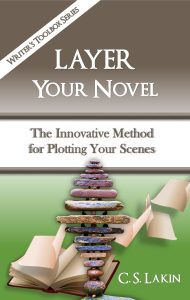How to Effectively “Advance Your Plot”
Ever read a scene in a novel, get to the end, and scratch your head?
Have you ever asked, “What the heck was the purpose of that scene? Nothing really happened—at least nothing interesting or _____? (important, revealing, tense, or funny … you fill in the blank).
Every scene needs to advance your plot.
What does that mean, though?
I’ll get there in a minute. But, first, let’s consider purpose.
Every Scene Must Have a Purpose
It should be obvious that every scene—and let me emphasize every—should have a purpose.
It makes me think of the purposeful scene in the movie Babe in which the stuck-up cat lays out for Babe the pig what his impending fate is and why. Let’s listen in on part of their conversation:
Cat: And they even say that you don’t know what pigs are for.
Babe: What do you mean, what pigs are for?
Cat: You know, why pigs are here?
Babe: Why are any of us here?
Cat: Well, the cows are here to be milked; the dogs are here to help the Boss’s husband with the sheep; and I’m here to be beautiful and affectionate to the Boss …
Babe: Yes?
Cat: Ah, the fact is, pigs don’t have a purpose. Just like ducks don’t have a purpose.
Babe: Uh, I .. I don’t … uh …
Cat: Oh, all right. For your own sake, I’ll be blunt. Why do the Bosses keep ducks? To eat them. So why do the Bosses keep a pig? The fact is that animals that don’t seem to have a purpose really do have a purpose. The Bosses have to eat. It’s probably the most noble purpose of all, when you come to think about it.
Babe: They … eat … pigs?
Cat: Pork, they call it. Or bacon. They only call them pigs when they’re alive.
Babe : But, uh, I’m a sheep pig.
Cat : [giggles] The Boss’s husband’s just playing a little game with you. Believe me, sooner or later, every pig gets eaten. That’s the way the world works. Oh … I haven’t upset you, have I?
We aren’t left guessing why this scene is purposeful—it’s meant to give Babe doubts about Farmer Hoggett, whom he believes is a true friend with Babe’s best interest at heart. It’s meant to propel Babe into his dark night of the soul moment, which threatens to destroy his heart’s desire to be the best sheep-pig in the world (though, it’s likely he’s the only one in existence). Which would sabotage the plot goal—participating in and winning the sheep trials. It’s meant to put a rift of suspicion between the two main characters, adding tension and raising the stakes.
All this and more in this one scene. You see—scenes can accomplish many things, but they must primarily accomplish one thing …
Propelling the plot forward toward the dramatic climax.
You might argue: well, that’s an important scene, so of course it has a purpose.
I would answer: in a great story, every scene has a purpose. Not only that—every single word and action, even the mention of a gesture or expression, serves a purpose.
Just that truth should get you fine-combing through every line in your manuscript to ensure, yes, it all serves a purpose.
So … now that we got that out of the way, let’s deal with the even more important purpose of this post: to explain how to nail the purpose of your novel.
Here’s the kind of thing I see in many of the hundreds of manuscripts I critique every year:
I read the synopsis of the story, and it’s a suspense thriller about a woman whose expensive, rare ancient necklace has been stolen to use in a dark ritual. In her attempt to get it back, she’s abducted and soon to be sacrificed in that ritual wearing that necklace because, of course, her family line has some inherent power that the nemesis covets and by killing her he will absorb that power. Her boyfriend/treasure hunter/former Navy Seal is on the tail of the bad guy hell-bent on rescuing her, promising an exciting nail-biting confrontation at the climax.
Great premise, I think. Lots of potential for high action and drama, high stakes, an emotional ride, tense climax. Perfect premise for the genre. Readers will love it.
Writing ability aside, this promises to be a well-structure story with purposeful scenes … because the writer has laid out all the significant plot elements in the synopsis.
Then … I start reading the manuscript.
Scene after scene goes by … and I’m wondering when the author will mention the necklace. By the midpoint, I’ve finally seen the protagonist at an event where her necklace is on display with other ancient artifacts. But nothing’s really happened in the story so far.
In fact … all the opening scenes are lighthearted, about her boyfriend and their dinner dates. Filled with lots of small talk—boring, predictable dialogue—with no tension, no inner or outer conflict, no mystery, nothing at stake.
I’m sure you can see what’s wrong here.
First and foremost, the writer hasn’t done her genre homework. The book sounds more like a rom-com (romantic comedy) sans the “com.” That’s one absolute essential to nailing the purpose of your novel.
Readers have a purpose when they sit down and open a book—they have expectations of enjoying a novel they think is in the genre it claims to be in. How upsetting when that novel fails to deliver what’s rightly expected.
For every scene in your novel to work, it has to fit genre expectations. Don’t dismiss that.
The only way to “advance your plot” is to build scenes to support your premise.
What’s a premise? It’s a situation the presupposes the need for action. In other words: something’s the matter, and someone needs to deal with it. Yes, that’s your protagonist. And her goal. Which gets resolved at the climax, and then the book ends shortly after.
Uninformed or inexperienced writers think that the first chunk of their novel needs to explain and set up background on the characters, details about their world, show how they interact with others … and, eventually, maybe by the midpoint, start bringing in the situation the premise hinges on.
All that stuff mentioned above—that’s what the first scene—the setup scene—needs to accomplish. And shortly after that should follow what’s called the inciting incident (or disturbance or opportunity). That incident is what showcases the premise.
I would expect in that example I gave that by chapter 2 the necklace has already been stolen and the stakes are high. By chapter 3 I’d look for the character to be in danger and shortly abducted after that.
It’s really quite simple if you know basic story structure. And therein lies the problem for many writers.
 They don’t know story structure. And, in almost every case, that equates to novel failure.
They don’t know story structure. And, in almost every case, that equates to novel failure.
The good news is learning story structure is easy. There are foundational scenes—key scenes—that the entire story is built on. You can start with those—what I call the 10 Key Scenes—and learn where they go and what they must accomplish. From there you add in more scenes (I use a layering method that works every time, and it’s laid out in Layer Your Novel.)
Indeed, the purpose of your novel, ultimately, is to entertain your readers—whether you intend to make them bite off all their nails, jump for joy, cry their heart out, or all three.
But to accomplish that purpose, you have to have a strong, enticing premise that fits a specific genre (and has all the genre markers), with every scene “advancing the plot.”
Advancing how, in what way?
Purposefully—to play out the premise you’ve come up with. Amid rising high stakes and conflict, tension and obstacles, twists and setbacks, and all those glorious things readers love in the novels they read.
Every scene needs to end with a punch, a high moment that indicates how the character has changed in the scene (yes, in every scene) and hinting at what’s at stake (yes, in every scene). If a scene has nothing at stake, no high moment punched home at the end, nothing new revealed, then … it has no purpose.
And we know what happens to things that don’t serve a purpose—they meet their doom.
So be sure to study genre and story structure. Don’t waste your time writing purposeless scenes. Craft a great premise and make every word count. Then make sure every scene advances your plot in a specific, intentional way.
Featured Photo by Gaelle Marcel on Unsplash






With three books published, I thought I understood the need for each scene to serve the story, but I read your article nonetheless. And, eureka, I understood the reason why I’m not happy with my WIP. I am so mired up in trying to explain how my characters’ past experiences inform their actions, that I’d forgotten that golden rule. So thanks for the wakeup call, and thanks for the well-presented reminder. Revision pays!
When you say build the openings of the premise, do you mean take
bits from the premise then what you say about the inciting incident, showcase the premise, what does that mean?
Your premise is the situation your protagonist is dealing with for the bulk of the novel. So every scene has to have the premise is mind. The inciting incident sets the character moving in a new direction, and every scene needs to impact the character’s attempt to reach his or her goal. If your premise is about a man who is searching for a lost treasure, then every scene in the novel, once he’s underway (basically after the initial setup scene), affects that goal, either helping or hindering him. Scenes that are wholly unrelated to the premise don’t belong. Imagine if Little Red Riding Hood decided, halfway to Granny’s house, to build a chicken coop and raise chickens so she can sell the eggs to buy a car. That’s totally off track. Does that make sense?